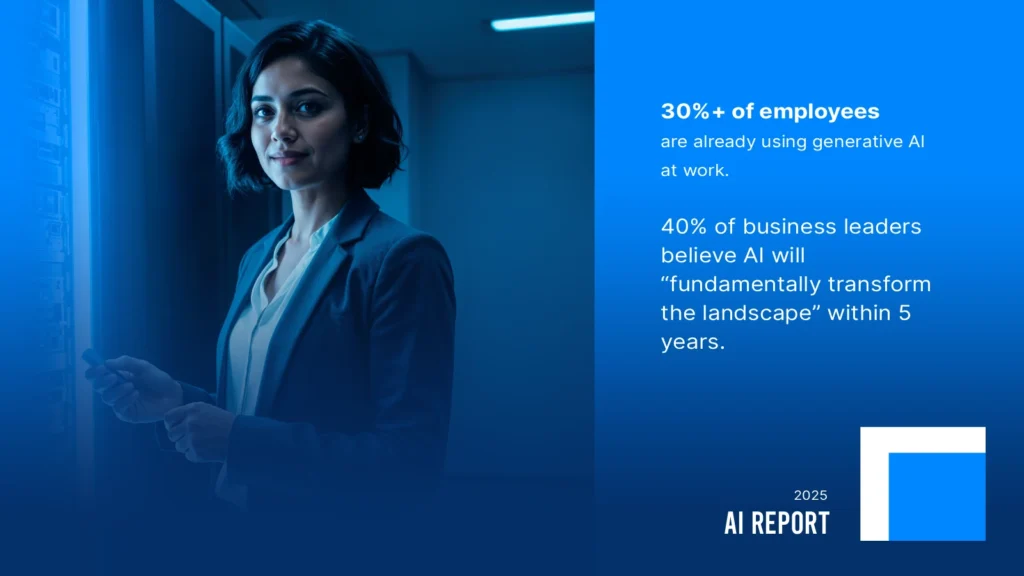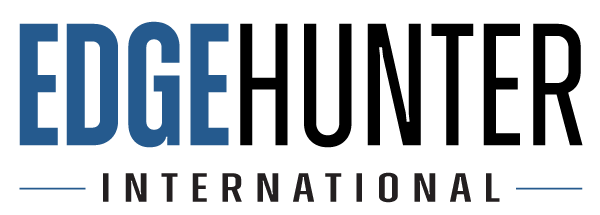Over 30% Use Generative AI at Work: How It’s Reshaping Talent, Governance & Competitive Advantage
Walk into almost any office today, and chances are someone is already using ChatGPT, Claude, or another generative AI tool. The latest numbers show that over 30% of employees are already adopting AI tools in their daily work (McKinsey). That’s not a future trend—it’s the present reality.
But here’s the bigger question: where is this headed, and how do organizations prepare for it without being left behind?
At Edge Hunter, we’ve seen firsthand that AI isn’t just a tech upgrade—it’s a competitive reset button. And if leaders don’t have a clear plan for talent, governance, and integration, they’ll struggle to catch up.
In this post, you’ll walk away with a clear picture of how AI is entering workplaces today, the biggest roadblocks organizations face, and the practical steps leaders can take to get ahead. We’ll unpack adoption trends across industries, highlight the risks and governance gaps slowing progress, and explain how to build a future-ready talent strategy.
And most importantly, we’ll explore what it takes to turn AI from an experimental add-on into a true competitive advantage.
| Highlight | Brief Description |
|---|---|
| AI Adoption Today | Over 30% of employees use generative AI tools in workplaces, with adoption growing in IT, marketing, sales, and manufacturing. |
| Leading Industries | Industries with high data needs and efficiency demands, such as IT, marketing, healthcare, and manufacturing, are adopting AI faster. |
| Key Obstacles | Main challenges include AI skill gaps in HR (27%), technical/integration issues (17%), and employee resistance (16%). |
| Governance Importance | Strong governance ensures ethical AI use, regulatory compliance, data privacy, and trust among employees and customers. |
| Value Creation Strategies | AI creates value by improving productivity, enhancing relationships, augmenting intelligence, and winning the war for data. |
| Future Outlook | In 5 years, AI will reshape industries; humans remain essential for creativity, emotional intelligence, and decision-making. |
| Best Practices | Focus on skill development, governance, technology infrastructure, change management, and strategic vision for successful AI adoption. |
| Competitive Impact | Companies that integrate AI deeply and align talent, governance, and data are likely to become dominant players in their industries. |
Current State of AI Adoption in Workplaces
Companies are approaching AI adoption in waves. At first, many organizations experimented with generative tools like ChatGPT for quick wins—drafting emails, summarizing documents, or generating marketing copy. These bottom-up use cases often spread faster than leadership anticipated, creating “shadow AI” practices where employees test tools without formal oversight.
Today, adoption is maturing: firms are piloting structured AI initiatives in recruitment, customer support, financial modeling, and supply chain optimization. For most, AI adoption is not yet enterprise-wide, but pockets of innovation are proving the ROI and nudging leadership toward larger-scale deployment.

AI use at work is climbing faster than many expected.
-
30%+ of employees are already using generative AI at work.
-
40% of business leaders believe AI will “fundamentally transform the landscape” within 5 years, leaving only a few dominant players standing.
-
AI adoption is most common in IT, sales & marketing, and product development—functions where efficiency and creativity can be turbocharged.
As Gallup noted, employee use of AI tools has nearly doubled in just two years. Yet, very few organizations provide formal guidance on how to use AI responsibly. This creates a gap: people are experimenting with powerful tools without a roadmap.
In other words, organizations are moving from experimentation to integration.
Which functions / industries are leading
Not every industry is moving at the same pace. IT and technology functions naturally lead the pack, using AI to automate testing, code generation, and infrastructure monitoring.
Marketing and sales teams are close behind, leveraging AI for personalized campaigns, lead scoring, and predictive analytics.
In manufacturing, AI is being tested in quality control, predictive maintenance, and even design optimization.
Healthcare is another hotspot, applying AI to diagnostics, patient engagement, and drug discovery.
What’s clear is that industries with high volumes of data and a strong need for efficiency—such as finance, telecom, and logistics—are the earliest adopters. By contrast, sectors that rely heavily on manual labor or have strict regulatory environments, like public administration, tend to lag.
The competitive view: what leaders are saying
Business leaders are not shy about their expectations. According to surveys, 40% believe AI will fundamentally transform the competitive landscape in their industry within five years. That doesn’t mean gradual improvement—it means entire markets could consolidate around a few AI-advanced players who know how to combine talent, data, and governance effectively.
Leaders consistently say the winners will not just be those who buy AI tools but those who reimagine processes, redefine roles, and move faster than competitors. The sense of urgency is clear: if your rival masters AI before you, they may lower costs, attract top talent, and capture customer loyalty at a speed you cannot match.
Experts like Satya Nadella, CEO of Microsoft, emphasize that “digital transformation is the core of business reinvention in the 21st century,”
For executives, the question is shifting from “Should we adopt AI?” to “How fast can we scale before competitors outpace us?”
The Talent & Skills Gap
This is where most organizations hit a wall.
When surveyed about the biggest obstacle in integrating AI into talent management systems, leaders pointed to:
-
27%: Insufficient AI-related knowledge and skills within HR teams
-
17%: Technical challenges like compatibility and data security
-
16%: Employee resistance due to change management issues
At Edge Hunter, we worked with a mid-sized manufacturing client who had ambitious plans to use AI for workforce planning and predictive analytics. The problem? Their HR team didn’t have the skills to interpret AI-generated insights. Instead of cutting corners, we built a training program that combined AI literacy with change management coaching. Within six months, not only did the team feel comfortable using AI, but employee resistance dropped because communication was transparent.
And here’s the larger point: AI is not replacing humans—it’s amplifying them. 44% of professionals believe employees will need to develop new skills to thrive in AI-driven workplaces. But beyond technical upskilling, what’s needed is a meta-competency: learning agility, emotional intelligence, and adaptability.
Governance, Infrastructure & Risk
Governance in AI is not bureaucracy—it’s survival. Without proper structures, AI adoption exposes organizations to risks ranging from biased decision-making to regulatory fines and data breaches.
Why governance structures matter
Governance ensures that AI is aligned with business strategy, ethical standards, and legal obligations. It provides transparency into how models make decisions and who is accountable when mistakes happen. Beyond compliance, governance also builds trust among employees and customers, both of whom want assurance that AI is used responsibly.
Think of governance as the operating system for AI: without it, even the most advanced applications will eventually crash.
AI adoption at scale requires not just enthusiasm but governance structures and guardrails. Success hinges on aligning four key elements:
-
People
-
Software
-
Hardware
-
Data
Without these, even the best AI tool becomes a liability.
Technical / infrastructure challenges
Adopting AI is not as simple as plugging in a new app. Organizations face significant technical and infrastructure challenges.
Many legacy systems are not compatible with AI tools, creating integration headaches.
Data security is another pressing issue: models require large volumes of sensitive information, which raises the stakes for breaches.
- 42% of organizations have already strengthened cybersecurity measures because of AI adoption (AJG Benchmarking Survey).
Poor data hygiene—duplicate, outdated, or incomplete records—can compromise outputs and create false insights. Companies also struggle with model monitoring: once deployed, AI needs to be continuously updated, retrained, and audited for accuracy and fairness.
- A TechRadar/F5 report found that only 2% of enterprises consider themselves “highly ready” for AI, with governance, model oversight, and data integrity lagging far behind.
Without robust infrastructure—secure cloud environments, scalable data pipelines, and reliable APIs—AI cannot move from small experiments to enterprise-scale solutions.
The Competitive Landscape: How Value is Created
McKinsey’s research confirms this: nearly every company plans to increase AI investments, but those that align talent + governance + data infrastructure will extract the most value.
As one executive recently put it:
“AI is not about doing the same work faster—it’s about rethinking what work should look like in the first place.”
AI creates value through four interconnected strategies:
Improve productivity
Automating repetitive tasks, streamlining workflows, and allowing employees to focus on higher-value activities. For example, AI can handle resume screening in seconds, freeing recruiters to spend more time on candidate engagement.
Enhance relationships
AI-driven insights allow for more personalized interactions with customers, partners, and even employees. Chatbots can provide 24/7 support, while predictive analytics can anticipate client needs before they surface.
Augment intelligence
Rather than replacing human decision-making, AI enhances it. Leaders can make smarter, data-backed decisions, reducing bias and spotting trends humans might miss. Imagine a CFO using AI not just for financial forecasting but for scenario planning under different economic conditions.
Win the war for data
In the AI era, data is the ultimate differentiator. Companies that control large, high-quality datasets gain an edge that’s difficult to replicate. This is why many organizations are now prioritizing data governance, privacy, and enrichment as a strategic priority.
The most competitive companies are those that don’t treat these four as silos but weave them into a unified strategy.
What Needs to Be Done:
If you’re a CHRO, CEO, or talent leader, the question is: what do you need to prioritize right now?
Here are some steps Edge Hunter recommends based on our work with clients:
-
Audit your current AI usage: Where is AI already being used, formally or informally?
-
Upskill your teams: Build AI literacy, but also train on emotional intelligence, trust-building, and adaptability.
-
Set governance guardrails: Define policies, compliance, and ethical use frameworks before problems arise.
-
Pilot before scaling: Use AI in targeted pilots, learn from them, then expand with confidence.
-
Lead with transparency: Communicate openly to reduce fear and resistance. Make it clear that humans and AI are collaborators, not competitors.
Best Practices & Recommendations
Skill Development
AI is only as powerful as the people who use it. That’s why upskilling HR teams and employees in AI literacy, data literacy, and change management is critical. Training should not only cover technical aspects like prompt engineering or model evaluation but also equip employees with adaptability and learning agility. Role-based training programs help employees see how AI applies to their day-to-day responsibilities, while embedding learning agility ensures teams can adapt as technologies evolve.
Governance & Policy
Clear AI usage policies and ethical frameworks are the guardrails that keep innovation safe. Organizations need oversight mechanisms, from model validation processes to regular bias audits. Privacy and security standards must be built in, not bolted on. Establishing a governance board that includes IT, legal, HR, and business leaders ensures AI decisions reflect multiple perspectives and accountability lines are clear.
Technology & Infrastructure
Organizations must ensure system compatibility, data hygiene, and security before scaling AI. Integration with existing platforms (ERP, CRM, ATS) is often a bigger challenge than model development itself. Ongoing monitoring is also crucial: leaders must track AI outcomes, detect biases, and make adjustments in real time. A neglected model quickly becomes an inaccurate one.
Change Management
AI adoption isn’t just technical—it’s cultural. Employee resistance is real, and transparency is the antidote. Communicating openly about what AI will and won’t do helps reduce fear. Phased or pilot approaches allow organizations to test AI in controlled environments, gather feedback, and build confidence. Most importantly, leaders should frame AI as a collaborator, not a competitor—humans remain central to the process.
Strategic Vision
AI adoption without vision is just experimentation. Leaders must set bold goals and define where AI is core to the business versus where it plays a support role. Investments should align with long-term value creation rather than chasing hype. Companies that integrate AI into their strategic roadmap will outpace those who dabble in pilots without direction.
Future Outlook & Scenarios
5-Year Outlook
The next five years will likely see the rise of AI-leaders—organizations that master adoption, governance, and talent readiness to capture outsized market share. Employee roles will shift significantly: repetitive administrative work will decline, while demand for roles requiring creativity, problem-solving, and interpersonal skills will grow.
Entirely new job classes will emerge, including AI auditors, ethics officers, and prompt engineers. The workplace of 2030 may look very different, but humans will still play the starring role.
Possible Challenges
-
Regulatory/compliance risks: Governments worldwide are moving toward stricter AI regulations. Non-compliant organizations could face fines, lawsuits, or reputational damage.
-
Bias, fairness, and data privacy: These issues remain unresolved. AI that makes decisions about hiring, promotions, or performance reviews must be monitored closely to avoid discrimination.
-
Over-reliance on AI: Blind trust in algorithms can backfire. AI should inform decisions, not dictate them. Human oversight is non-negotiable.
-
Societal/cultural resistance: Not every geography or workforce embraces AI at the same pace. In some regions, skepticism toward automation may slow adoption. Leaders must balance innovation with sensitivity to cultural context.
Conclusion
AI adoption is accelerating, but success requires more than tools. It demands skilled people, strong governance, resilient infrastructure, and a bold strategic vision. Companies that align these elements will not only survive the AI revolution—they’ll thrive in it.
So here’s the recap:
-
Adoption is happening now, not tomorrow.
-
Obstacles are real—skills gaps, governance issues, infrastructure limits—but solvable.
-
Value creation comes from combining productivity, relationships, intelligence, and data into one coherent strategy.
What leaders should start doing now: audit your current AI usage, upskill your teams, establish governance, and align your AI strategy with long-term business goals.
And the final question: What is your company’s plan for AI five years from now—to lead, to adapt, or to risk being left behind?



